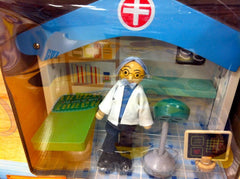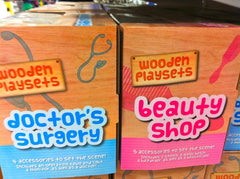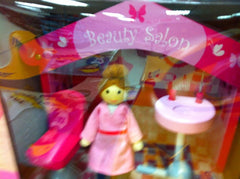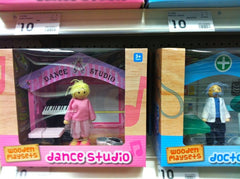In a few days Andrew and I will celebrate the eighth anniversary of our life together. Almost a decade of love, loyalty, support, mutual respect and happiness (and, yes, of challenges and compromises too). Our life together is joyful, blessed and complete. It is not, however, a marriage.
We are yet to stand at an altar to sign a contract and publicly declare our love. We declare it in private frequently enough (maybe too much – I’m sure it would be sickening if anyone could overhear us…even the dog rolls his eyes!). There are many reasons why a wedding has not been the right fit for us so far, and most of these are far too personal (and too unrelated to Montessori!) to share in this forum. What is relevant is that neither one of us feels compelled to get married yet. We both feel safe, secure, comfortable and content exactly as we are.
So why does society still seem to assume that obviously I want to get married, and that I’m just desperately waiting until Andrew is ready?! People ask Andrew “Why are you keeping her waiting?” while asking me “When do you think he’ll pop the question?”. They don’t think to ask me “Do you want to get married?” or “Are you ready to get married?” or even “What is the reason why you two have decided not to get married at this stage?”. They don’t think to ask Andrew “Do you think she would say yes if you asked?”. Most people work from the hypothesis that I’m waiting and he’s procrastinating. So why is this the default setting for strangers, acquaintances friends and family alike? Two words: gender stereotypes.
I’m the girl. He’s the boy. So I’m the one who wants to dress up in a white gown and he’s the one who’s scared of commitment. That’s what society sees because it is so deeply ingrained into our culture, our media and our advertising. It’s in movies, on TV, in our books. But it’s not true. Not always. And not in this case.
We are both equally happy with things exactly as they are. But…and I’ll admit this for the greater good…sometimes I get confused. Sometimes when people constantly ask me about it I start to believe in the stereotype myself. I start to feel like maybe there is something wrong with me. Maybe they’re right – why doesn’t he want to marry me? Why hasn’t he asked me yet? When will I get to wear that gown? These thoughts aren’t my own, but they appear in my head nonetheless and they make me feel insecure. I sometimes find it hard to separate my internal voice from the external peer pressure. The doubts permeate my walls, seeping in from the deeply entrenched gender roles of the world around me and slowly chip away at my confidence and sense of contentment. They are insidious and hurtful and I wish I could make them go away. And I’m a grown up.
So imagine how it feels for little girls. Little girls who lack the self-control, self-awareness, life experience and perspective to even begin to try to identify these creeping doubts as external rather than internal. Little girls who literally have to buy into the princess fantasy almost from birth. And how does it feel for little boys, who are told explicitly and implicitly that to be ‘good enough’ they need to be as strong and tough as a lycra-clad superhero.
Every day, all around us, we are surrounded by gender stereotypes. Sadly it is in childhood, when our little individuals are most impressionable and vulnerable, that these stereotypes are most aggressively promoted and consistently reinforced.
***I want to make it really clear from this point onwards that if you are a parent, relative or teacher who buys princess pink for girls and battle-ready blue for boys, that is your choice and I'm not judging you for it! My opinions on the issue are strong, but I'm not arrogant or naive enough to believe that my opinions are the absolute truth. My feelings are carefully considered and constructed but they are not beyond question.
You might buy pink for girls and blue for boys because you feel it's cute and harmless. You might do it because you agree with some of the gender distinctions that it implies. You might do it because you have strong and thoughtfully formed views on why it is appropriate or positive. It's also possible that you might do it simply because you just haven't stopped to think about it yet. If you fall into this last category then maybe I can provoke that conscious consideration here, so that you can start making deliberate choices rather than following your default setting.
Regardless of your reasons, if you choose pink for your girls and blue for your boys then just be aware that we hold a slightly different opinion from one another but I don't think that mine is better than yours! I'm just enacting my right to choose, and I'm respecting yours too!
If you'd like to know more about my perspective then I invite you to read on. But if you feel sure that reading about an alternative opinion will just make you feel anxious, angry or guilty then you could just click away if you want! Honestly, the internet is already filled with people making each other feel angry without anyone moving closer to a more enlightened or well-rounded perspective, we don't need to generate more of that here! I do think debate and dissent is important for growth, but if you are not ready or interested then you don't have to invite guilt or negativity into your day! Go read something that makes you happy and proud, and maybe come back one day if you do feel ready to think more deeply about this topic.***
I know many parents who try to promote “gender neutral” attitudes in their homes and then seem genuinely surprised when their little girls still wear fairy wings while their little boys dress as Spiderman. We’ve all heard the story (is it a joke, an urban legend or a genuine anecdote?) of the little girl who is given toy trucks by a forward-thinking parent…and then proceeds to put a nappy on the truck and put it in a crib. These parents sometimes conclude that these attitudes therefore simply must be driven by some internal force, that their little girl must biologically love pink and their little boy is predisposed to be drawn to blue.
What these parents might be forgetting is that it takes a village to raise a child, whether you want it to or not. These ‘gender-neutral’ parents are not holding their child on an isolated island. The child still absorbs influences from not-so-progressive sources.
Gender stereotypes are everywhere. They are all around us – some subtle, some glaringly obvious. It’s in toy stores – with a big pink section of pretty dolls clearly intended for sweet, nurturing, placid girls, and a big blue section of construction and vehicles meant for active, brave, strong boys. It’s in clothing stores, it’s on TV, it’s in movies and books and even in our families and friends.
We are a pretty progressive society but we still fall into the traditional default surprisingly frequently. Honestly ask yourself how many “stay at home dads” you know compared to “stay at home mums”. Ask yourself how many female superheroes there are compared to their male counterparts. Ask yourself whether the words “male fairy” sound natural to you…or if they sound like an insult.
Oh, and in case you think I’m overreacting or living in the past, here are some photos from 3 days ago in a store (which shall remain unnamed, but trust me there is one near you!) close to my home and Pre-school…



Yep, I think this falls into the 'glaringly obvious' category of gender stereotyping (and disgusting, antiquated and insulting stereotyping at that!). Blue boys are doctos. Pink girls are beauticians. I was furious. Enraged. Incensed. I am sure that I embarrassed Andrew enormously by snapping repeated photos of the offending toys while very loudly proclaiming my disgust. I kept ranting as we walked through the toy section and just as I was calming down there was this…

Oh yes, don’t worry girls, your options aren’t limited. You don’t have to be a beautician – you could also be a DANCER! (And boys, the implication is that you can’t be a dancer). Another few steps along the toy aisle and I reach the Lego, at which point the ranting begins again because…



Faaaaaaaantastic. Girls love pink and ponies and that darn beauty salon again (and can't handle too many steps in the building process). Boys love heroes and ninjas (and can put together complex constructions). In case it seems like I'm just a lonesome fusspot, here are some other reputable sources who are equally offended by Lego's limited and limiting gender view. Ironically Lego seems to be going backwards; they used to be much more "progressive". Their multi-coloured building blocks used to be promoted equally to all little creative hands and minds. Now their sets are so clearly differentiated along gender lines that there are websites allowing you to 'mashup' a girl's ad with a boy's ad because of how hilariously mismatched they are!
I work with Pre-school aged children - the target market listed on the boxes of the toys mentioned above. Tiny little humans who have only been on this world for three or four years. Yet they already feel extremely strongly about what is for boys and what is for girls. These are the children of intelligent, enlightened, progressive, conscientious parents. These are children who still loudly proclaim “boys can’t wear pink, pink is for girls”. A child recently passed out invitations to his birthday party and one of his classmates flatly refused the believe the invitation was really from him because "the invitation is pink - it must be for a girl's party".
Sometimes it makes me incredibly sad to hear these words coming from a tiny child’s mouth. They might sound ‘innocent’ enough, but they are the seeds that can grow into a close-minded and restrictive world-view. The same world-view that leads to ‘stereotype threat’ causing girls to perform poorly in maths exams despite their skills. Yet I also know that these young children have the chance to change these perceptions before they become deeply ingrained beliefs. This requires some thoughtful action and intervention from the adults who are entrusted with the noble task of helping to guide and form these little minds. The parents, teachers, relatives and friends who can influence and enlighten the blossoming beliefs of our next generation.
It is true that these caring adults can sometimes feel as though they are fighting a losing battle against the weight of society. ‘Society’ is an immeasurably complex system. I can’t personally break down or identify all of the subsections into which gender stereotypes have embedded themselves (or been actively cultivated). What I can do is control my own actions and make a considered effort to avoid perpetuating gender stereotypes to the children who I teach, to the families who I engage with, to the individuals who access support and resources through Montessori Child. I can choose not to let the weight of society break down my own values, and I can encourage other adults to make this choice too.
It is this last point in particular that has given me a renewed sense of passion about this subject. When I search through wholesale catalogues and websites I am inevitably (and depressingly) confronted by a very clearly defined line between the “girls” and “boys” toys. It is surprisingly hard to find gender-neutral items; the assumption seems to be that girls must have pretty pink frills while boys must have cars and action heroes. My first wholesale order for Montessori Child included a ‘Chef Set’ and an Apron. Both of these came in a selection of colours – the former in pink, blue or green and the latter in (you guessed it) pink, blue or yellow. So, of course, we chose the green and the yellow, respectively, because these do not suggest any gender alignment. And guess what – the wholesale supplier emailed me and recommended that we get the pink or blue in each because they sell better for girls and boys. I appreciated the customer service, but I firmly declined. I’d rather sell fewer items than feel as though I’m compromising my values.
Now don’t get me wrong – I’m not saying girls can’t like pink and boys can’t like blue. That would be just as discriminatory and close-minded. I have no right to dictate what is right or wrong for another individual. But I know that my choice doesn't actually infringe on anyone else's freedom - there are already plenty of places that parents can find a pink apron for girls and blue apron for boys if that's what they want. If we lived in a world where stocking a pink apron didn’t imply that it was for girls then I would happily offer that colour choice. However, I don’t believe that this is the case. I believe that stocking a pink apron loudly implies that it is the “Girl’s” apron. I feel strongly that if I put this on my site it would be purchased primarily for little girls and it would insinuate that I recommended that. So I choose to draw a line for myself, and for the resources that I promote. It probably means that I sometimes lose sales, as people go looking for the familiar comfort of the ‘pink and blue’, but I’d rather lose sales than compromise my values.
Sometimes we do occasionally stock something that is predominantly pink, or blatantly blue. This tends to happen when I encounter a resource that is amazingly irresistible but isn't available in a neutral colour/pattern. When this happens I deliberately take the extra time to recommend that it is equally appropriate for both genders. This is how I achieve a sense of personal balance about providing access to meaningful, quality materials without sacrificing my convictions on the gender issue.
I am not alone in this choice. In the United Kingdom there is an organised activists convincing major retailers to "Let Toys Be Toys" rather than defining which gender they belong to! There are Australians thinking this might be a good course of action here too!
Ultimately, however, the majority of retailers will stock what sells. So we get stuck in a 'chicken and egg' scenario. Stores sell pink for girls because parents buy it. Parents buy pink for girls because their little girls seem to love it. Little girls love pink because they see it everywhere (in their peers, in their culture, in their environment) and because they receive so much of it. So the image of pink girly girls becomes more widespread and more pervasive. So more parents buy it, more shops stock it, more advertisers market towards it and more little girls are swamped in it. The same could be said of blue for boys. It is a self-perpetuating cycle. Trying to point the finger of blame at one element alone is like looking at a perfect circle and trying to find the "start". It's not the fault of the parents, it's not the fault of the retailers alone, it's not the fault of the marketers alone. It's definitely not the fault of the little girls and boys. So instead of looking for the start of the circle let's just try to create an end - we've got a metaphorical pencil, we can just draw a line straight through it to mark our 'end'. Let's each make a conscious, deliberate and informed choice about where we draw the line...and once we draw it, let's stick to it - even when the world tries to peer pressure us into erasing it!
If you have read this post and feel compelled to investigate further then please go read Delusions of Gender for a deeper exploration of the issue from a scientific perspective.

1 comment
Oct 10, 2013 • Posted by Linda
“The village” is ripe with gender stereotypes. For every time my father told me I could be anything and anyone I want to be, society sent me a message about what a ‘girl’ should be. As many of these messages are subliminal, we accept them as children (and as adults!). Thank goodness, my Grandmother always chose to wear blue. She had a career when women typically didn’t, and married late in life although she met her true love early on. And when she did marry, she married by choice. By example, she showed me that being a girl could mean being strong, independent and yes… wearing blue! Equally, being a boy can mean dancing, loving ponies and wearing pink or blue! Thank you for your post, and for wearing blue shirts to work! The awareness behind that decision is so important for all those who care for children.
Leave a comment: